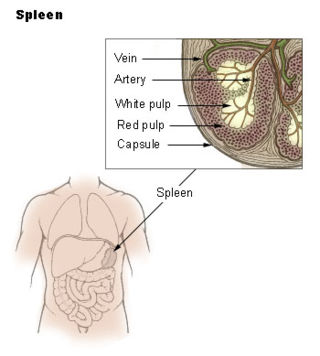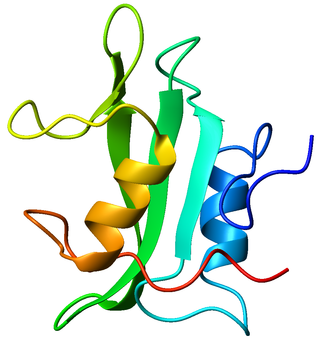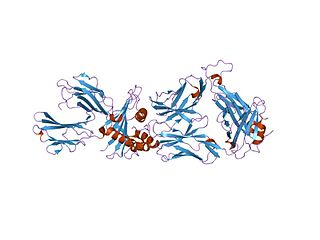Related Research Articles

In immunology, an antigen (Ag) is a molecule, moiety, foreign particulate matter, or an allergen, such as pollen, that can bind to a specific antibody or T-cell receptor. The presence of antigens in the body may trigger an immune response.

Immunology is a branch of biology and medicine that covers the study of immune systems in all organisms.
Opsonins are extracellular proteins that, when bound to substances or cells, induce phagocytes to phagocytose the substances or cells with the opsonins bound. Thus, opsonins act as tags to label things in the body that should be phagocytosed by phagocytes. Different types of things ("targets") can be tagged by opsonins for phagocytosis, including: pathogens, cancer cells, aged cells, dead or dying cells, excess synapses, or protein aggregates. Opsonins help clear pathogens, as well as dead, dying and diseased cells.
Pathogen-associated molecular patterns (PAMPs) are small molecular motifs conserved within a class of microbes, but not present in the host. They are recognized by toll-like receptors (TLRs) and other pattern recognition receptors (PRRs) in both plants and animals. This allows the innate immune system to recognize pathogens and thus, protect the host from infection.
Pattern recognition receptors (PRRs) play a crucial role in the proper function of the innate immune system. PRRs are germline-encoded host sensors, which detect molecules typical for the pathogens. They are proteins expressed, mainly, by cells of the innate immune system, such as dendritic cells, macrophages, monocytes, neutrophils and epithelial cells, to identify two classes of molecules: pathogen-associated molecular patterns (PAMPs), which are associated with microbial pathogens, and damage-associated molecular patterns (DAMPs), which are associated with components of host's cells that are released during cell damage or death. They are also called primitive pattern recognition receptors because they evolved before other parts of the immune system, particularly before adaptive immunity. PRRs also mediate the initiation of antigen-specific adaptive immune response and release of inflammatory cytokines.

The marginal zone is the region at the interface between the non-lymphoid red pulp and the lymphoid white-pulp of the spleen.

Lck is a 56 kDa protein that is found inside specialized cells of the immune system called lymphocytes. The Lck is a member of Src kinase family (SFK), it is important for the activation of the T-cell receptor signaling in both naive T cells and effector T cells. The role of the Lck is less prominent in the activation or in the maintenance of memory CD8 T cells in comparison to CD4 T cells. In addition, the role of the lck varies among the memory T cells subsets. It seems that in mice, in the effector memory T cells (TEM) population, more than 50% of lck is present in a constitutively active conformation, whereas, only less than 20% of lck is present as active form of lck. These differences are due to differential regulation by SH2 domain–containing phosphatase-1 (Shp-1) and C-terminal Src kinase.

An immune complex, sometimes called an antigen-antibody complex or antigen-bound antibody, is a molecule formed from the binding of multiple antigens to antibodies. The bound antigen and antibody act as a unitary object, effectively an antigen of its own with a specific epitope. After an antigen-antibody reaction, the immune complexes can be subject to any of a number of responses, including complement deposition, opsonization, phagocytosis, or processing by proteases. Red blood cells carrying CR1-receptors on their surface may bind C3b-coated immune complexes and transport them to phagocytes, mostly in liver and spleen, and return to the general circulation.

Paneth cells are cells in the small intestine epithelium, alongside goblet cells, enterocytes, and enteroendocrine cells. Some can also be found in the cecum and appendix. They are located below the intestinal stem cells in the intestinal glands and the large eosinophilic refractile granules that occupy most of their cytoplasm.

Myeloid differentiation primary response 88 (MYD88) is a protein that, in humans, is encoded by the MYD88 gene.

Toll-like receptor 2 also known as TLR2 is a protein that in humans is encoded by the TLR2 gene. TLR2 has also been designated as CD282. TLR2 is one of the toll-like receptors and plays a role in the immune system. TLR2 is a membrane protein, a receptor, which is expressed on the surface of certain cells and recognizes foreign substances and passes on appropriate signals to the cells of the immune system.
Immunosenescence is the gradual deterioration of the immune system, brought on by natural age advancement. A 2020 review concluded that the adaptive immune system is affected more than the innate immune system. Immunosenescence involves both the host's capacity to respond to infections and the development of long-term immune memory. Age-associated immune deficiency is found in both long- and short-lived species as a function of their age relative to life expectancy rather than elapsed time. It has been studied in animal models including mice, marsupials and monkeys. Immunosenescence is a contributory factor to the increased frequency of morbidity and mortality among the elderly. Along with anergy and T-cell exhaustion, immunosenescence belongs among the major immune system dysfunctional states. However, while T-cell anergy is a reversible condition, as of 2020 no techniques for immunosenescence reversal had been developed.

Cancer/testis antigen 1 also known as LAGE2 or LAGE2B is a protein that in humans is encoded by the CTAG1B gene. It is most often referenced by its alias NY-ESO-1.

MiR-155 is a microRNA that in humans is encoded by the MIR155 host gene or MIR155HG. MiR-155 plays a role in various physiological and pathological processes. Exogenous molecular control in vivo of miR-155 expression may inhibit malignant growth, viral infections, and enhance the progression of cardiovascular diseases.

Sir Stephen Patrick O'Rahilly is an Irish-British physician and scientist known for his research into the molecular pathogenesis of human obesity, insulin resistance and related metabolic and endocrine disorders.
Mucosal-associated invariant T cells make up a subset of T cells in the immune system that display innate, effector-like qualities. In humans, MAIT cells are found in the blood, liver, lungs, and mucosa, defending against microbial activity and infection. The MHC class I-like protein, MR1, is responsible for presenting bacterially-produced vitamin B2 and B9 metabolites to MAIT cells. After the presentation of foreign antigen by MR1, MAIT cells secrete pro-inflammatory cytokines and are capable of lysing bacterially-infected cells. MAIT cells can also be activated through MR1-independent signaling. In addition to possessing innate-like functions, this T cell subset supports the adaptive immune response and has a memory-like phenotype. Furthermore, MAIT cells are thought to play a role in autoimmune diseases, such as multiple sclerosis, arthritis and inflammatory bowel disease, although definitive evidence is yet to be published.

Gabrielle T. Belz is an Australian molecular immunologist and viral immunologist. She is a faculty member of the Walter and Eliza Hall Institute of Medical Research, within the Molecular Immunology division. Belz has made important contributions to the understanding of immune system function, especially in relation to the molecular and cellular signalling pathways of immune response to viruses. Her research has focused on understanding the signals that drive the initial development of protective immunity against pathogen infections, such as influenza and herpes viruses. This includes research into how cytotoxic T cells recognise and remove virally-infected cells from the body following infection. Research into the description of the specific factors and response during infection will contribute towards the long-term development of vaccines for infectious disease, and the development of better treatments for autoimmune diseases.
David Arthur Tuveson is an American cancer biologist and is currently Roy J. Zuckerberg Professor of Cancer Research as well as The Cancer Center Director at Cold Spring Harbor Laboratory. Dr. Tuveson is also the Chief Scientist for the Lustgarten Foundation for Pancreatic Cancer Research. He is known for developing some of the first mouse models of pancreatic cancer and more recently, for his work developing pancreatic cancer organoids.

Type 3 innate lymphoid cells (ILC3) are immune cells from the lymphoid lineage that are part of the innate immune system. These cells participate in innate mechanisms on mucous membranes, contributing to tissue homeostasis, host-commensal mutualism and pathogen clearance. They are part of a heterogeneous group of innate lymphoid cells, which is traditionally divided into three subsets based on their expression of master transcription factors as well as secreted effector cytokines - ILC1, ILC2 and ILC3.
Mitchell Kronenberg is an American immunologist and the chief scientific officer at La Jolla Institute for Immunology. He served as president of the institute from 2003 to 2021.
References
- 1 2 3 "FEARON, Prof. Douglas Thomas" . Who's Who . Vol. 2015 (online Oxford University Press ed.). A & C Black.(Subscription or UK public library membership required.)
- ↑ "Douglas Fearon". Debretts.
- 1 2 Nuzzo, R. (2005). "Biography of Douglas T. Fearon". Proceedings of the National Academy of Sciences . 102 (21): 7415–7417. doi: 10.1073/pnas.0502415102 . PMC 1140442 . PMID 15899974.
- ↑ Feig, C; Jones, J. O.; Kraman, M; Wells, R. J.; Deonarine, A; Chan, D. S.; Connell, C. M.; Roberts, E. W.; Zhao, Q; Caballero, O. L.; Teichmann, S. A.; Janowitz, T; Jodrell, D. I.; Tuveson, D. A.; Fearon, D. T. (2013). "Targeting CXCL12 from FAP-expressing carcinoma-associated fibroblasts synergizes with anti-PD-L1 immunotherapy in pancreatic cancer". Proceedings of the National Academy of Sciences. 110 (50): 20212–7. Bibcode:2013PNAS..11020212F. doi: 10.1073/pnas.1320318110 . PMC 3864274 . PMID 24277834.
- ↑ Roberts, E. W.; Deonarine, A; Jones, J. O.; Denton, A. E.; Feig, C; Lyons, S. K.; Espeli, M; Kraman, M; McKenna, B; Wells, R. J.; Zhao, Q; Caballero, O. L.; Larder, R; Coll, A. P.; O'Rahilly, S; Brindle, K. M.; Teichmann, S. A.; Tuveson, D. A.; Fearon, D. T. (2013). "Depletion of stromal cells expressing fibroblast activation protein-α from skeletal muscle and bone marrow results in cachexia and anemia". Journal of Experimental Medicine . 210 (6): 1137–51. doi:10.1084/jem.20122344. PMC 3674708 . PMID 23712428.
- ↑ Fearon, D. T.; Locksley, R. M. (1996). "The instructive role of innate immunity in the acquired immune response". Science. 272 (5258): 50–3. Bibcode:1996Sci...272...50F. doi:10.1126/science.272.5258.50. PMID 8600536. S2CID 21383755.
- ↑ "Douglas Fearon". Cold Spring Harbor Laboratory. Retrieved 30 April 2020.
- ↑ "EC/1999/15: Fearon, Douglas Thomas". London: The Royal Society. Archived from the original on 5 April 2015. Retrieved 5 April 2015.